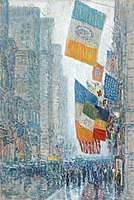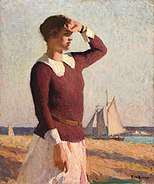Huntington Museum of Art
The Huntington Museum of Art is an art museum located in the hills above Ritter Park in Huntington, West Virginia. Housed on over 50 acres of land and occupying almost 70,000 square feet, it is the largest art museum in West Virginia. The museum's campus is also home to nature trails and the C. Fred Edwards Conservatory, a subtropical plant conservatory. The museum's collections include American and European paintings, sculptures, prints, and drawings, as well as glass pieces manufactured in West Virginia and the Ohio Valley, American folk art, Chinese and Japanese decorative items, Haitian art, firearms, and material culture objects from the Near East. In addition to its permanent collections, the museum hosts traveling exhibitions and houses the James D. Francis Art Research Library, the Grace Rardin Doherty Auditorium, and five art studios where artists in residence are periodically hosted.[1][2]
- For The Huntington Museum, Art Collections, Library and Botanical Gardens in San Marino, California see The Huntington Library.
 Location within West Virginia | |
| Location | 2033 McCoy Road Huntington, West Virginia |
|---|---|
| Coordinates | 38.393036°N 82.434411°W |
| Type | Art museum |
| Director | Geoffrey Fleming |
| Curator | Chris Hatten |
| Website | hmoa.org |
History
The Huntington Museum of Art first opened on November 9, 1952 under the name The Huntington Galleries. The museum came under its current name in 1987. The building was built on a 52-acre plot donated by Herbert Fitzpatrick who also donated his personal art collection to begin the museum’s collection. This donation of more than 400 objects was a mixture of fine arts and decorative arts among which were paintings and prints, sculptures, silver, rugs, and Asian decorative objects.
Also on display during the opening of the Huntington Galleries was the Dean Firearms Collection, loaned to the museum by Herman Dean, a member of the first board of the Galleries. This collection is now a permanent exhibit at the museum.
In the mid-1960s an addition was added onto the original building funded by the Henry L. and Grace Rardin Doherty Foundation. This addition of what would become the Grace Rardin Doherty Auditorium along with additional exhibit space and three more studios was designed by famed architect Walter Gropius and his firm The Architects Collaborative.
Two more studios would be added in the 1980s and 1990s along with a gallery to house the Near Eastern objects, the C. Fred Edwards Conservatory, and additional office space.[3]
Collections
American Art
The American Art Collection is made up of a variety of art ranging from paintings, print, and sculpture to decorative arts and folk art. Works by artists such as Childe Hassam, John Singer Sargent, Robert Henri, Andrew Wyeth, and Andy Warhol are included in the collection.[2]
European Art
The European Art Collection comprises a large number of works of painting, prints, drawings, sculpture, and decorative arts. Works by artists such as Jean-Baptiste-Camille Corot, Jean Francois Millet, Georges Braque, and Pablo Picasso are included in the collection.[2]
Asian Art
Founded by the donation of Asian decorative objects by Herbert Fitzpatrick when the museum first opened, the collection of Asian Art has grown to include prints, paintings, sculpture, and textiles.[2]
Inuit Art and Sculpture
A small collection of Inuit art from the 1950s was collected by Herman Dean and largely consists of sculpture.[2]
Daywood Collection
The Daywood Collection was given to the Huntington Museum of Art in 1970 by Ruth Woods Dayton, and added almost 400 works of art to the museum’s already existing collection. The Daywood Collection has a strong emphasis on late 19th and early 20th century American art with a focus on American Impressionism, but also contributes a number of important pieces by European artists. Collected by Mrs. Dayton and her husband Arthur Dayton during their lives, Mrs. Dayton wished for the collection to remain in West Virginia to benefit the people of the state. After the Walter Gropius addition to the museum was completed, the collection was given to the museum where it could now be appropriately housed.[4]
Touma Near Eastern Collection
Largely consisting of works donated to the museum by Drs. Joseph B. and Omayma Touma in the 1990s and early 2000s, the Touma Near Eastern Collection contains more than 400 works of art in a wide range of media. The collection is housed in the Touma Near Eastern Gallery which was built in 1996 and was designed with the help of the Toumas to create a cultural context for the collection.[2]
Herman P. Dean Firearms Collection
Herman Dean’s collection of firearms displays a wide variety of historical firearms from the earliest hand cannon up to weapons of the 19th century, with a special focus on the weapons of the American frontier.[2]
Winslow Anderson Collection of Haitian Art
The collection of Haitian paintings and sculptures is largely made up of a donation of art to the museum by former Blenko Glass designer Winslow Anderson.[2]
Glass Collection
The museum’s glass collection is its largest collection with more than 4,000 objects ranging in date from ancient to contemporary and showing the work of many glass companies, with a special focus on glass of the mid-Western/Ohio Valley. A selection of the collection is on permanent view in the Glass Gallery. A significant addition to the collection is a large Dale Chihuly tower that is located in the C. Fred Edwards Conservatory. The Wilbur Myers Glass Collection is also a part of this collection.[2]
Gallery
 Childe Hassam, Lincoln's Birthday Flags - 1918, 1918
Childe Hassam, Lincoln's Birthday Flags - 1918, 1918 Frank Benson, The Watcher, 1921
Frank Benson, The Watcher, 1921
C. Fred Edwards Conservatory
The C. Fred Edwards Conservatory was opened in 1996 and is the only plant conservatory in West Virginia. The tropical and subtropical plants featured in the conservatory fall under the categories of Orchids, Agriculturally Important, Fragrant, and Unusual.
- Orchids – The orchid collection includes over 100 varieties of orchids.
- Agriculturally Important – The plants classified as agriculturally important are ones that are eaten or used in some way. Examples are cashew, chocolate, banana, papaya, sugarcane, and coffee.
- Fragrant – Fragrant plants are those that characteristically give off strong aromas.
- Unusual – The collection of unusual plants refers to plants that are not commonly known to us in our daily lives such as the pitcher plant, the turtle plant, and the sensitive plant.
A variety of fish and frogs can also be found in the conservatory.[2]
References
- Gillispie, John (11 October 2010). "Huntington Museum of Art". e-WV: The West Virginia Encyclopedia. Retrieved 10 December 2015.
- "Huntington Museum of Art". HMOA.org. Retrieved 10 December 2015.
- Hatten, Christopher (2014). Mr. Fitz: Herbert Fitzpatrick and the Founding of the Huntington Museum of Art. Huntington Museum of Art. The Fitzpatrick Society. Retrieved June 27, 2018.
- The Art of Patronage: The Daywood Collection. 2017. Huntington Museum of Art. Retrieved July 3, 2018.
